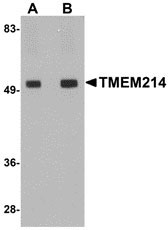TMEM214 Antibody
- SPECIFICATION
- CITATIONS
- PROTOCOLS
- BACKGROUND

Application
| WB, E |
|---|---|
| Primary Accession | Q6NUQ4 |
| Other Accession | NP_060197, 134152721 |
| Reactivity | Human, Mouse, Rat |
| Host | Rabbit |
| Clonality | Polyclonal |
| Isotype | IgG |
| Calculated MW | 77151 Da |
| Application Notes | TMEM214 antibody can be used for detection of TMEM214 by Western blot at 1 - 2 µg/mL. |
| Gene ID | 54867 |
|---|---|
| Target/Specificity | TMEM214; |
| Reconstitution & Storage | TMEM214 antibody can be stored at 4℃ for three months and -20℃, stable for up to one year. As with all antibodies care should be taken to avoid repeated freeze thaw cycles. Antibodies should not be exposed to prolonged high temperatures. |
| Precautions | TMEM214 Antibody is for research use only and not for use in diagnostic or therapeutic procedures. |
| Name | TMEM214 |
|---|---|
| Function | Critical mediator, in cooperation with CASP4, of endoplasmic reticulum-stress induced apoptosis. Required or the activation of CASP4 following endoplasmic reticulum stress. |
| Cellular Location | Endoplasmic reticulum membrane; Multi-pass membrane protein |

Thousands of laboratories across the world have published research that depended on the performance of antibodies from Abcepta to advance their research. Check out links to articles that cite our products in major peer-reviewed journals, organized by research category.
info@abcepta.com, and receive a free "I Love Antibodies" mug.
Provided below are standard protocols that you may find useful for product applications.
Background
TMEM214 Antibody: Transmembrane protein 214 (TMEM214) is a 77kD membrane protein which is widely expressed at high level. The gene encoding this protein maps to chromosome 2, at 2p23.3 TMEM214 interacts with LSM1, an SM-like protein, forming a stable heteromer present in tri-snRNP particles, which are important for pre-mRNA splicing. The detailed function of TMEM214 is still unknown, but a recent study showed that TMEM214 may be used to explore the contribution of human host factors of some infectious diseases such as Dengue fever, West Nile fever and yellow fever. Multiple isoforms of TMEM214 are known to exist.
References
Wan D, Gong Y, Qin W, et al. Large-scale cDNA transfection screening for genes related to cancer development and progression. Proc. Natl. Acad. Sci. U S A2004;101:15724-9.
Lehner B and Sanderson CM. A protein interaction framework for human mRNA degradation. Genome Res.2004; 14:1315-23.
Sessions OM, Barrows NJ, Souza-Neto JA, et al. Discovery of insect and human dengue virus host factors. Nature2009; 458:1047-50.
If you have used an Abcepta product and would like to share how it has performed, please click on the "Submit Review" button and provide the requested information. Our staff will examine and post your review and contact you if needed.
If you have any additional inquiries please email technical services at tech@abcepta.com.













 Foundational characteristics of cancer include proliferation, angiogenesis, migration, evasion of apoptosis, and cellular immortality. Find key markers for these cellular processes and antibodies to detect them.
Foundational characteristics of cancer include proliferation, angiogenesis, migration, evasion of apoptosis, and cellular immortality. Find key markers for these cellular processes and antibodies to detect them. The SUMOplot™ Analysis Program predicts and scores sumoylation sites in your protein. SUMOylation is a post-translational modification involved in various cellular processes, such as nuclear-cytosolic transport, transcriptional regulation, apoptosis, protein stability, response to stress, and progression through the cell cycle.
The SUMOplot™ Analysis Program predicts and scores sumoylation sites in your protein. SUMOylation is a post-translational modification involved in various cellular processes, such as nuclear-cytosolic transport, transcriptional regulation, apoptosis, protein stability, response to stress, and progression through the cell cycle. The Autophagy Receptor Motif Plotter predicts and scores autophagy receptor binding sites in your protein. Identifying proteins connected to this pathway is critical to understanding the role of autophagy in physiological as well as pathological processes such as development, differentiation, neurodegenerative diseases, stress, infection, and cancer.
The Autophagy Receptor Motif Plotter predicts and scores autophagy receptor binding sites in your protein. Identifying proteins connected to this pathway is critical to understanding the role of autophagy in physiological as well as pathological processes such as development, differentiation, neurodegenerative diseases, stress, infection, and cancer.


